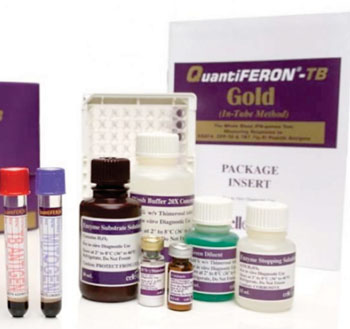Effective Way to Diagnose Latent Tuberculosis Identified
By LabMedica International staff writers
Posted on 05 Jun 2014
The effective control and elimination of tuberculosis (TB) in low-incidence countries requires the prompt identification of individuals with active and latent TB infection (LTBI).Posted on 05 Jun 2014
The diagnosis of latent TB is important because the bacterium can persist in the body only to emerge and reactivate months or even years later. Therefore treating individuals with latent TB can prevent disease developing and so prevent them infecting others.

Image: The QuantiFERON-TB Gold In-Tube whole blood enzyme-linked immunosorbent assay (ELISA) for the diagnosis of tuberculosis (Photo courtesy of Cellestis).
Scientists at University of Birmingham (Edgbaston, UK) working with colleagues from other British institutes performed a prospective, longitudinal cohort study among 166 Nepalese military recruits who had left Nepal and recently entered the UK. The study was carried out from February to September 2012, and assessed longitudinal interferon (IFN)-gamma release assays (IGRA) and tuberculin skin test (TST) responses. They also studied the influence of antecedent TST and LTBI treatment on IGRA performance.
Two commercially available assays were used. The QuantiFERON-TB Gold In-Tube (QFT-GIT; Cellestis; Carnegie, Australia) a whole blood enzyme-linked immunosorbent assay (ELISA), and the T-SPOT.TB assay (Oxford Immunotec; Abingdon, UK) enzyme-linked immunospot (ELISPOT) assay using peripheral blood mononuclear cells (PBMCs). On the day following blood sampling for the IGRAs, a TST was performed by the Mantoux method.
The IGRA testing revealed that 21 individuals were T-SPOT.TB positive (12.9%, with two who were borderline positive, and eight were QFT-GIT positive (4.8%). All QFT-GIT positives were also T-SPOT.TB positive. Thus, 61.9% T-SPOT.TB positive participants were QFT-GIT negative, meaning the tests showed moderate agreement.
Adam F. Cunningham, PhD, the senior author of the study and a professor of Functional Immunity, said, “One of the problems with latent TB is that it is very tricky to diagnose. We have found this test is the best way for diagnosing latent TB in this group. What we found was that one IGRA was more effective at identifying latent TB infected individuals than the other tests. This commercially-produced test, called T-Spot, is a blood test that measures T cells specific to certain Mycobacterium tuberculosis antigens. It is cost-effective because individuals only require one visit to be tested.” The study was published on May 9, 2014, in the journal Public Library of Science ONE.
Related Links:
University of Birmingham
Cellestis
Oxford Immunotec














